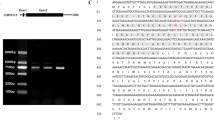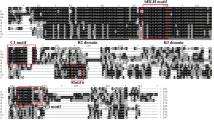Abstract
The fruit of Lonicera caerulea L. is rich in anthocyanin, which has beneficial effects on human health. However, there is no research report on the regulation mechanism of anthocyanin synthesis in Lonicera caerulea L. TT8 gene-encoded protein belongs to bHLH transcription factor, and it has been reported to regulate anthocyanin synthesis. In the study, we cloned TT8 gene from Lonicera caerulea L. named “Berel” and transformed into tobacco (Nicotiana tabacum) to characterize its function. The open-reading frame of LcTT8 was 2049 bp, encoding a protein of 682 amino acids. The phylogenetic tree analysis showed that LcTT8 protein had the highest homology with TT8 in Paeonia suffruticosa. The analysis of expression in different tissues showed that the expression level of LcTT8 was higher in fruits than that in flowers, leaves, stems, and roots, and the expression level reached the peak at the early stage of fruit color change. The subcellular localization results showed that the LcTT8 protein was mainly localized in the nucleus. A total of ten LcTT8 overexpression transgenic tobacco were obtained. The ELISA results revealed that the anthocyanin content in the transgenic tobacco leaves was increased by 36.84% compared with the wild-type tobacco. The qPCR results showed that the overexpression of LcTT8 caused the up-expression of key genes of anthocyanin synthesis, including F3H, DFR, and ANS. Similarly, the enzyme activities of DFR and ANS were significantly increased in the transgenic lines (P < 0.05). Our research reveals the expression patterns and molecular characteristic of LcTT8 gene in anthocyanin synthesis, providing new possibilities for the breeding of blue honeysuckle and other fruit plants with high anthocyanin accumulation.










Similar content being viewed by others
References
Appelhageni JO, Bartelniewoehner L (2011) Leucoanthocyanidin dioxygenase in Arabidopsis thaliana: characterization of mutant alleles and regulation by MYB-BHLH-TTG1 transcription factor complex. Gene 484:61–68
Baldi P, Orsucci S, Moser M (2018) Gene expression and metabolite accumulation during strawberry (Fragaria × ananassa) fruit development and ripening. Planta 248:1143–1157
Baudey A, Caboche M, Loic L (2006) TT8 controls its own expression in a feedback regulation involving TTG1 and homologous MYB and bHLH factors, allowing a strong and cell-specific accumulation of flavonoids in Arabidopsis thaliana. Plant J 39:366–380
Chen L, Xin X, Lan R (2014) Isolation of cyanidin 3-glucoside from blue honeysuckle fruits by high-speed counter-current chromatography. Food Chem 152:386–390
Dong Y, Wang C, Han X (2014) A novel bHLH transcription factor PebHLH35 from Populus euphratica confers drought tolerance through regulating stomatal development, photosynthesis and growth in Arabidopsis. Biochem Biophys Res Commun 450:453–458
Giusti M, Wrolstad RE (2001) Characterization and measurement of anthocyanin by UV-visible spectroscopy. Curr Protocol Food Anal Chem 1:F1–F2
Gong ZZ, Yamagishi E, Yamazaki M (1999) A constitutively expressed Myc-like gene involved in anthocyanin biosynthesis from Perilla frutescens: molecular characterization, heterologous expression in transgenic plants and transactivation in yeast cells. Plant Mol Biol 41:33–44
Guang YQ, Song GC, Zhang JF (2014) Cloning and expression analysis of a new cotton bHLH gene GhbHLH130. Cotton J 26:363–370
Imene H, Francois BJ (2011) Recent advances in the transcriptional regulation of the flavonoid biosynthetic pathway. J Exp Bot 62:2465–2483
Jurgonski A, Juskiewicz J, Zdunczyk Z (2013) An anthocyanin-rich extract from Kamchatka honeysuckle increases enzymatic activity within the gut and ameliorates abnormal lipid and glucose metabolism in rats. Nutrition 29:898–902
Ke M, Qing LD, Chao L (2017) Genome wide identification and characterization of apple bHLH transcription factors and expression analysis in response to drought and salt stress. Front Plant Sci 8:480
Li P, Chen B, Zhang G (2016) Regulation of anthocyanin and proanthocyanidin biosynthesis by Medicago truncatula bHLH transcription factor MtTT8. New Phytol 210:905–921
Liu D, Xin M, Zhou X (2017) Expression and functional analysis of the transcription factor-encoding gene CsERF004 in cucumber during Pseudoperonospora cubensis and Corynespora cassiicola infection. BMC Plant Biology 17:96
Liu XY, Han HQ, Ge HY (2014) Cloning, expression and interaction of anthocyanin-related transcription factors Sm TTG1, Sm GL3 and Sm TT8 in eggplant. Acta Hortic Sin 11:9
Matsuoka K (2019) Anthocyanins in Apple fruit and their regulation for health benefits// Anthocyanins - novel antioxidants in human health and diseases prevention [working title]
Moyer RA, Hummer KE, Finn CE, Wrolstad RE (2002) Anthocyanin, phenolics, and antioxidant capacity in diverse small fruits: vaccinium, rubus, and ribes. J Agric Food Chem 50:519–525
Mushtaq MA, Qi P, Dao ZC (2016) Comparative leaves transcriptome analysis emphasizing on accumulation of anthocyanin in brassica: molecular regulation and potential interaction with photosynthesis. Front Plant Sci 7:311
Nesi N, Debeaujon I, Jong (2000) The TT8 gene encodes a basic helix-loop-helix domain protein required for expression of DFR and BAN genes in Arabidopsis siliques. Plant Cell 12: 1863–1878
Ohno S, Hosokawa M, Hoshino A (2011) A bHLH transcription factor, Dv IVS, is involved in regulation of anthocyanin synthesis in dahlia (Dahlia variabili). J Exp Bot 62:5105–5116
Padmaja LK, Agarwal P, Gupta V (2014) Natural mutations in two homologous TT8 genes control yellow seed coat trait in allotetraploid Brassica juncea (AABB). Theoretical & Applied Genetics Theoretische Und Angewandte Genetik 127:339–347
Peng FW, Ling S, Huan HG (2018) Genome-wide characterization of bHLH genes in grape and analysis of their potential relevance to abiotic stress tolerance and secondary metabolite biosynthesis. Front Plant Sci 9:64–77
Ramsay NA, Walker AR, Mooney M (2003) Two basic-helix-loop-helix genes (MYC-146 and GL3) from Arabidopsis can activate anthocyanin biosynthesis in a whiteflowered Matthiola incanamutant. Plant Mol Biol 52:679–688
Su J, Yang N, Wang XF (2017) Cloning, subcellular localization and expression analysis of Salvia miltiorrhiza SmbHLH37 gene. J Agric Biotechnol 25:884–892
Wang GJ (2013) The Effect of anthocyanin on the prostate in an andropause animal model: rapid prostatic cell death by apoptosis is Partially Prevented by Anthocyanin Supplementation. World J Mens Health 31:239
Wang Y (2018) Overexpression of a Malus baccata WRKY transcription factor gene (MbWRKY5) increases drought and salt tolerance in transgenic tobacco. Can J Plant Sci 99:173–183
Wang YG, Li HY (2017) Tissue expression and subcellular localization of sugar beet BvBHLH92 gene. J Eng, Heilongjiang University 3:45–49
Wang LS, Stoner GD (2008) Anthocyanin and their role in cancer prevention. Cancer Lett 269:281–290
Wang DZ, Mo XT, Zhang X (2018a) Cloning and functional analysis of maize transcription factor ZmbHLH4 gene. China Agric Sci Technol Herald 20:16–25
Wang YC, Wang N, Xu HF (2018b) The expression of cold signal gene MdICE1 in red meat apple and its interaction with MdMYB. J Hortic 45:7–16
Wu S, He X, Wu X (2015) Inhibitory effects of blue honeysuckle (Lonicera caerulea L.) on adjuvant-induced arthritis in rats: crosstalk of anti-inflammatory and antioxidant effects. J Funct Foods 17:514–523
Yoshida K, Ma D, Constable CP (2015) The MYB182 protein down-regulates proanthocyanidin and anthocyanin biosynthesis in poplar by repressing both structural and regulatory flavonoid genes. Plant Physiol 167:693–710
Zhai Y, Yu K, Cai S (2020) Targeted mutagenesis of BnTT8 homologs controls yellow seed coat development for effective oil production in Brassica napus L. Plant Biotechnol J 18:1153–1168
Zhang C, Feng R, Ma R (2018) Genome-wide analysis of basic helix-loop-helix superfamily members in peach. PLoS One 13:e0195974
Zhong HY, Chen JW, Li CQ (2011) Selection of reliable reference genes for 9 expression studies by reverse transcription quantitative real-time PCR in litchi under different experimental conditions. Plant Cell Rep 30:641–653
Zhou Y, Liu X, ENGSTROM (2015) Control of plant stem cell function by conserved interacting transcriptional regulators[J]. Nature 517:377–380
Funding
This research was supported by the National Key Research and Development Project (2016YFC0500304), National Key R&D Program of China (2018YFD100200), Young Talents” Project of Northeast Agricultural University (19QC05), Heilongjiang Province Postdoctoral Startup Fund Postdoctoral Grant (LBH-Q17029), Natural Science Foundation of Heilongjiang Province of China (C2017020), and Natural Science Foundation of Heilongjiang Province of China (C2017015, C2017015).
Author information
Authors and Affiliations
Corresponding authors
Additional information
Publisher’s Note
Springer Nature remains neutral with regard to jurisdictional claims in published maps and institutional affiliations.
Key message
The expression patterns and molecular characteristic of LcTT8 gene of bHLH family were studied in anthocyanin synthesis, providing new possibilities for the breeding of blue honeysuckle and other fruit plants with high anthocyanin accumulation.
Rights and permissions
About this article
Cite this article
Liu, P., Gang, H., Liu, H. et al. Regulation of Anthocyanin Accumulation by a Transcription Factor LcTT8 From Lonicera caerulea L.. Plant Mol Biol Rep 39, 125–136 (2021). https://doi.org/10.1007/s11105-020-01229-8
Published:
Issue Date:
DOI: https://doi.org/10.1007/s11105-020-01229-8




